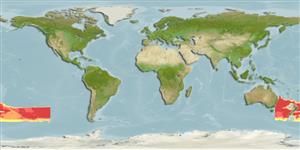Teleostei (teleosts) >
Lophiiformes (Anglerfishes) >
Gigantactinidae (Whipnose anglers)
Etymology: Gigantactis: Greek, 'gigas' or 'gigantos' = gigantic + Greek, 'aktis' = ray (referring to the unusually long first dorsal-fin spine that functions as a lure in this genus) (Ref. 86949).
Eponymy: Dr John Richard Paxton (d: 1938) is an American-born Australian ichthyologist. [...] (Ref. 128868), visit book page.
Environment: milieu / climate zone / depth range / distribution range
Ecology
Marine; bathypelagic; depth range 540 - 1500 m (Ref. 86949). Deep-water
Southwest Pacific.
Size / Weight / Age
Maturity: Lm ? range ? - ? cm
Max length : 29.5 cm SL male/unsexed; (Ref. 58502)
Short description
Identification keys | Morphology | Morphometrics
Dorsal soft rays (total): 6 - 7; Anal soft rays: 5 - 6. Metamorphosed females distinguished by the following characteristics: have filaments on the dorsal surface of head just behind the base of the illicium; length of illicium 168-198% SL; presence of short filaments on base of illicium; escal bulb gradually tapering into a conical, spinulose darkly pigmented distal prolongation, length 12-28% SL; escal bulb and distal prolongation bearing low unpigmented papillae; short filaments present on distal prolongation, absent on base of escal bulb; absence of posterior pair of close set illicial appendage; long dentary teeth (longest tooth 3.4-7.1% SL), three or four longitudinal series in posterior part of jaw; short rays of caudal fin (27.5-35% SL) (Ref. 86949).
Bathy- and mesopelagic species (Ref. 75154).
Life cycle and mating behavior
Maturity | Reproduction | Spawning | Eggs | Fecundity | Larvae
Paxton, J.R., D.F. Hoese, G.R. Allen and J.E. Hanley, 1989. Pisces. Petromyzontidae to Carangidae. Zoological Catalogue of Australia, Vol. 7. Australian Government Publishing Service, Canberra, 665 p. (Ref. 7300)
IUCN Red List Status (Ref. 130435: Version 2024-2)
Threat to humans
Harmless
Human uses
Fisheries: of no interest
Tools
Special reports
Download XML
Internet sources
Estimates based on models
Preferred temperature (Ref.
123201): 6.5 - 8.3, mean 7.8 °C (based on 9 cells).
Phylogenetic diversity index (Ref.
82804): PD
50 = 0.5000 [Uniqueness, from 0.5 = low to 2.0 = high].
Bayesian length-weight: a=0.01995 (0.00906 - 0.04395), b=3.01 (2.83 - 3.19), in cm total length, based on all LWR estimates for this body shape (Ref.
93245).
Trophic level (Ref.
69278): 4.2 ±0.7 se; based on size and trophs of closest relatives
Fishing Vulnerability (Ref.
59153): Low to moderate vulnerability (26 of 100).
